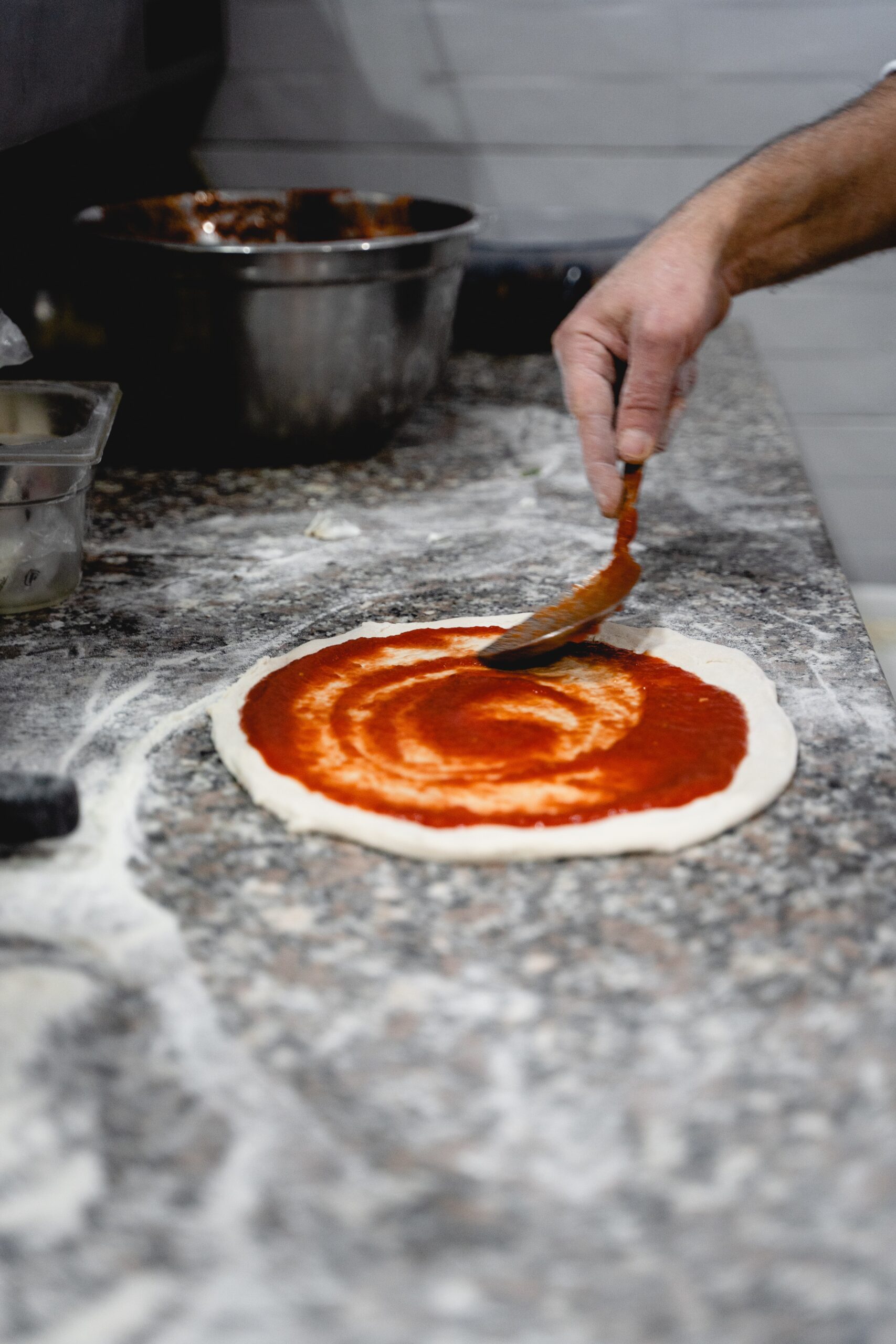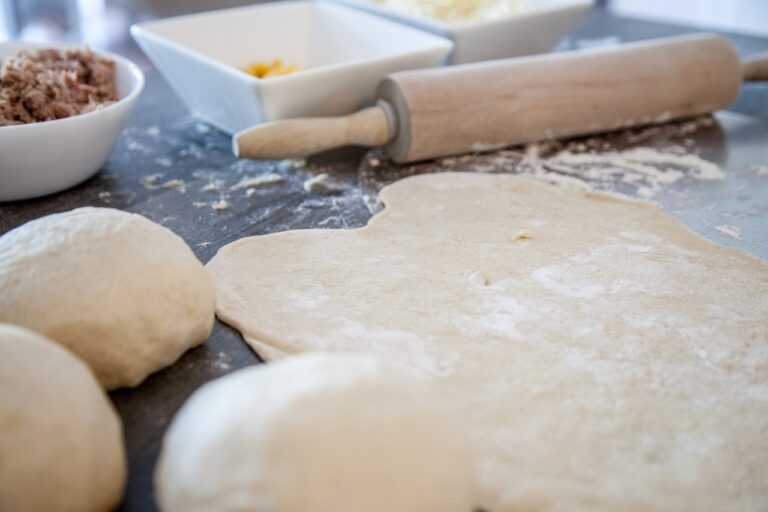Italian Pizza Crust Recipe
Are you looking to create the perfect Italian pizza crust? Look no further! In this article, we’ll guide you through crafting an authentic and crispy crust that will make your taste buds sing.
With our step-by-step instructions and essential ingredients, you can quickly whip up a delicious homemade pizza. Whether you’re a seasoned chef or just starting out, this recipe will satisfy your cravings for innovation and flavour. Let’s dive in and discover the secrets behind the mouthwatering world of Italian pizza crust!
The History of Italian Pizza Crust
You’ll be fascinated to learn about the rich history of Italian pizza crust. The evolution of Italian pizza crust is a journey that spans centuries, with each generation adding its unique touch to this beloved dish. The cultural significance of the Italian pizza crust cannot be overstated, as it has become a symbol of Italy’s culinary prowess and innovation.
The story begins in ancient times when flatbreads were baked on hot stones and topped with simple ingredients like olive oil and herbs. As time passed, these flatbreads evolved into what we now know as pizza crusts. In the 18th century, Naples became the birthplace of modern pizza, as street vendors started selling cheap and delicious pizzas topped with tomatoes and cheese.
Over the years, different regions in Italy have developed variations of pizza crust. In Rome, thin and crispy crusts became popular; thick and fluffy crusts known as ‘sfincione’ emerged in Sicily in Sicily. Each variation showcased the creativity and adaptability of Italian bakers.
The Italian pizza crust continues evolving, constantly introducing new techniques and flavours. From using alternative flours like whole wheat or gluten-free options to experimenting with unique toppings like truffle oil or arugula salad, chefs are continually pushing the boundaries of traditional pizza making.
Italian pizza crust holds a special place in the hearts and stomachs of people worldwide. Its rich history showcases Italy’s culinary heritage and spirit of innovation. So next time you bite into a slice of authentic Italian pizza, remember that you are experiencing a taste that has been perfected over centuries—a true testament to the cultural significance of Italian pizza crust.
Essential Ingredients for Authentic Italian Pizza Crust
Using a combination of flour, water, yeast, and salt creates the perfect base for an authentic Italian pizza crust. But did you know that there are different types of Italian pizza crusts? Each one has its unique texture and flavour.
Here are two sub-lists to help you understand the diversity of Italian pizza crusts:
Traditional Crusts
- Neapolitan: This is the classic pizza crust that originated in Naples. It’s thin and soft, with a slightly chewy texture. It’s usually cooked in a wood-fired oven at high temperatures to achieve that perfect charred edge.
- Roman: The Roman-style pizza crust is thin and crispy. It’s often rectangular and topped with simple ingredients like tomatoes, mozzarella, and fresh herbs.
Gluten-Free Options
- Cauliflower Crust: Cauliflower crust is a popular choice for those avoiding gluten. Made from grated cauliflower mixed with eggs and cheese, it bakes up crispy on the outside while still being tender on the inside.
- Chickpea Flour Crust: Another gluten-free option is using chickpea flour as a substitute for regular flour. This alternative gives your pizza crust a nutty flavour and a slightly denser texture.
Whether you prefer traditional or gluten-free options, experimenting with different types of Italian pizza crusts can excite your homemade pizzas. So go ahead, get creative in the kitchen, and enjoy your slice of innovation!
Making Italian Pizza Crust
To make the perfect Italian pizza crust, combine the essential ingredients and follow these step-by-step instructions.
There are different types of Italian pizza crusts, each with unique characteristics. Whether you prefer a thin and crispy crust or a thick and chewy one, a style of Italian pizza crust will suit your taste.
Firstly, it’s essential to use high-quality flour when making your dough. The type of flour you choose will significantly affect the texture and flavour of your crust. Many traditional Italian recipes call for Tipo 00 flour, which is finely ground and has a low protein content, resulting in a lighter, more delicate crust.
Next, ensure that you let your dough rise properly. This allows the yeast to do its job and create those excellent air pockets in the dough, giving it that light and airy texture we all love. Be patient during this process; rushing can lead to an underdeveloped dough.
Another common mistake to avoid is overloading your pizza with toppings. While it may be tempting to pile on all your favourite ingredients, it can weigh down the crust and prevent it from baking evenly.
By following these simple steps and avoiding common pitfalls, you’ll be well on your way to creating an authentic Italian pizza crust that will impress even the most discerning palates.
Get creative with different toppings and experiment with various styles of Italian pizza crust – innovation keeps this delicious dish evolving!

Tips and Tricks for Perfectly Crispy Italian Pizza Crust
Preheat your oven to the highest temperature before baking for a perfectly crispy texture. This is essential for achieving that golden and crispy crust we love on Italian pizza.
Here are some techniques to help you achieve the perfect crust, along with common mistakes to avoid:
-
Use high-quality flour: The type of flour you use can make a big difference in the texture of your crust. Opt for Italian Tipo ’00’ flour or bread flour, which has a higher protein content and will produce a chewier and crispier crust.
-
Stretch the dough properly: When stretching out your pizza dough, be gentle and avoid overworking it. This will ensure an airy and light crust with just enough chewiness.
Don’t overload with toppings: While it’s tempting to pile on them, remember that excessive moisture can lead to a soggy crust. Please keep it simple and use quality ingredients sparingly.
-
Use a pizza stone or steel: Preheating a pizza stone or steel in your oven will give your crust extra heat from underneath, resulting in a crisper bottom.
Variations and Toppings for Italian Pizza Crust
Remember that the key to a delicious pizza is balancing flavours and textures when trying different variations and toppings. Cheese is one of the most critical components of any Italian pizza crust. While mozzarella is a classic choice, why not get creative and experiment with different types of cheese? Gorgonzola adds a tangy and creamy twist, while fontina adds a nutty, buttery flavour to your crust. For those who love a bit of heat, try using pepper jack or even habanero cheddar for an extra kick.
But it’s not just about the cheese; the sauce also plays a crucial role. Traditional marinara sauce is always a safe bet, but don’t be afraid to think outside the box. How about a pesto base for a herby and vibrant taste? Or perhaps a spicy arrabbiata sauce for those who like it hot? If you’re feeling adventurous, experiment with barbecue sauce or curry paste for unique flavour combinations.
Remember, when it comes to toppings, there are no limits! Let your imagination run wild, from classic options like pepperoni and mushrooms to unconventional choices such as arugula or prosciutto. The key is finding the perfect balance between flavours and textures to make your Italian pizza crust unforgettable.
So go ahead and be innovative with your cheese selection and creative with your sauce options—the possibilities are endless!






